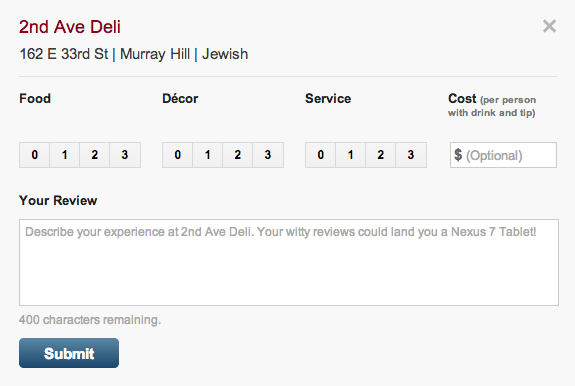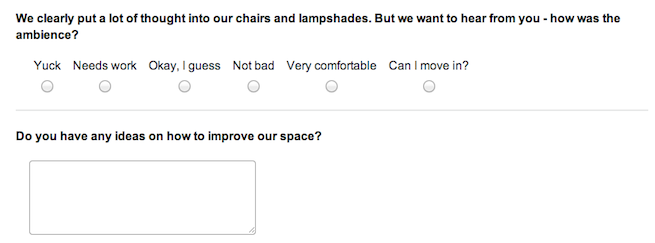From time to time I genuinely get the impression many restaurant managers and servers have very little idea why they’re asking their patrons to take the time to fill out a customer survey.
I’m not implying that they don’t care about improving the experience at a restaurant. However, based on the customer surveys I’ve seen in restaurants, they don’t seem to be directly related to any specific goal.
We’re going to do our best to change that.
Why Should Restaurants Use Customer Surveys?
The end goal isn’t to improve your profit margins. Nor is it to find out which of your dishes sells the best (you should already have that data). Nor is it to learn about the customer, how many were in their party, and how far they drove for your food. These are the kinds of metrics that consultants fuss over when deciding where to open a Pizza Hut franchise. But they aren’t the kinds of questions you should ask your customers during or after a recent visit.
The end goal is to find out what you can improve upon, make it clear to the customer that their feedback is indeed important to you, and then follow up on that feedback to improve the customer’s comprehensive experience. It’s only through return business and first-degree referrals that restaurants survive in a competitive environment.
Zagat vs. You
Also, before diving into survey design and question types, I should quickly touch on the difference between survey results gathered by an organization like Zagat and survey results gathered by you, the restaurant stakeholder.
The key difference is the intended goal. Zagat and other restaurant review organizations are collecting data in order to compare your restaurant to the other twenty or two hundred restaurants in the area, as well as against the same restaurants in your genre across the region, and possibly nation. The three short rating questions and review box in a Zagat survey are specifically designed to compare your restaurant to your competitors.

When you provide your users with a customer survey, you are not comparing your restaurant to your competitors. You are comparing yourself to your past self, or at times, a customer’s experience to their expectations. The questions you ask and how you ask them should absolutely reflect that key difference.
Restaurant Customer Survey Design
While the basic aesthetics aren’t all that important (a blue vs. green background or Courier vs. Times Roman), creating a survey that is clearly branded is important, not only to further associate a name or a logo, but because it gives the impression of direct communication to the stakeholder.
The respondents aren’t talking to a third party survey company lacking investment in the results – they are talking to you, the party most invested, both emotionally and financially. People tend to provide more thoughtful feedback when they know it will be received and not ignored, but given due attention by a decision maker.
Also very important to keep in mind is the idea survey fatigue, and the significance of avoiding it. Survey fatigue, like any other fatigue, is a tiring to an action or process. In this case, it is the tiring of providing feedback.
How do you avoid it? The best way to is to keep your surveys as short as possible. But shortening a twenty-question survey into one long table question isn’t the solution. The Golden Rule can be applied to survey fatigue – if you wouldn’t want to take it, don’t try to give it. Keep it short, keep it easy, and be thankful.
The Best Question Types For A Restaurant Customer Survey
As with many survey opportunities, including both quantitative and qualitative questions is going to be key in covering all bases. Over time, having quantitative feedback will help show performance improvements that you can then report on to owners, employees, and any other invested individual or group.
However, without having a face-to-face conversation with each customer after their visit, you won’t be able to collect specific advice on what needs improvement and what you are doing well. That’s where qualitative text boxes come in handy.

Give your customers an opportunity to use their own words, and you’ll be pleasantly surprised at the breadth of good ideas you receive. Think of it like a crowdsourcing experiment – give your customers the chance to design the experience they want, and maybe they’ll help you design an experience you’ll enjoy more as well.
Above is a screenshot from a sample survey made using online survey software, but with some the same result can be achieved with a hard copy survey.
Restaurant Customer Survey Implementation
Online vs. paper customer surveys – why not both? While online survey software is incredibly valuable in its ability to help your restaurant to collect, analyze and then compare historical data, not everyone will still be thinking about their experience after walking out the door of your establishment. Nor will they want to seek out a survey link on your website, even if it is mobile compatible.
For better or worse, we live in a time where businesses thrive and fail based solely on how easy their products and services are to access and use. The lesson? If you put the onus on the user anymore than absolutely necessary, you will fail to collect data.
You’ve undoubtedly been handed a bill at the end of a meal with a paper customer survey behind it, and this is actually a very effective strategy to gather data, while the experience is still fresh in the customer’s mind. The other often used tactic is a box or container of paper surveys that sit on the table, usually accompanied by those little yellow golf pencils.
While this may appeal to some for its passivity, it’s most often a resource only utilized when people are having an extreme experience, either positive or negative, that they feel needs to be shared. Perhaps their server was very attentive and friendly, and they want management to hear their praises. Or, maybe the steak was served cold and no one seemed to care – another reason you, as a patron, would want to voice your likely pejorative opinion to a stakeholder.
The point is, these individual surveys may contain short-term actionable feedback (reprimand or reward), but the data collected won’t be much help for long-term analysis in terms of strategy, as it really doesn’t paint an accurate picture without the perspective of an average experience.
So is there another way? The answer is clearly, yes. Always yes. As feedback and research analysis continues to become a necessary tool for small and medium sized business to succeed, the technology will grow with it.
Restaurant Customer Surveys Evolve
Websites like Yelp give customers an opportunity to rate and promote, while also posting photos and creating a communal discussion around a restaurant. And though it is important to monitor for trends and interact with your Yelp page, the 5-star scale is a bit limited in its insights.
We’ve recently seen businesses adopt simple payment systems like Square and Stripe, and the opportunity to implement a feedback loop within that payment process is ripe. After the swipe of a card through a Square plug-in, you’re asked to select a tip percentage, and then sign to authenticate the transaction. That usually ends the payment process and you’re free to leave and think of other things, like why Boagrius would be a suitable name for your archetypal first-born son, or why car insurance isn’t based on a per-mile pricing model.
Adding an additional step, a one-question customer survey to that payment process, would be a great way to seek well-sampled quantitative feedback. And it doesn’t need to be the same question every time – it could be randomly chosen from a bank of three or four questions. If the quality of the ambience, service, and food are the most important factors for you to track over time, you can have one of those three questions appear as a slider after every completed payment.

As the surveyor, you aren’t contributing to survey fatigue, in that you are placing this question in front of the respondents, seamless with an experience they were already prepared for. Furthermore, you aren’t taking up more than 10-20 seconds. This is vital.
Over the course of several weeks, you’ll gather actionable data on the metrics you are most invested in. Reporting on that data will show you which changes improved the customer’s experience, from their perspective.
Again, you’re missing out on qualitative data that really tells a story, but that’s exactly the point of a multi-pronged approach to collecting feedback. The more ears you open, the more you’ll hear.
Incentivized Restaurant Customer Surveys
Considering an incentivized customer survey? You may have the right goal in mind, but going about it the wrong way can be detrimental to the quality of the data your collect. Studies regularly show the bias effect various incentives play on the feedback received.
Instead of an upfront offer, like “Take our quick 10 minute survey and receive 50% off an order of breadsticks,” try rewarding the respondent after-the-fact with an unexpected personal note and a gift card. Even if it is in the follow-up, genuinely thoughtful customer service like that will only serve to improve the in-restaurant experience and increase the chances of repeat and referral business.
Act on Your Customer Survey Data
The worst thing you can do, far worse than creating a painfully long survey or incentivizing, or even leaving your business logo off the survey, is failing to act on the feedback you receive. Failing to act is a failure to respect the opinions of your customers, as well as their time. It sends a message to patrons and employees alike, that improvement is not a priority.
So act on it! Record your data, analyze it, measure it against past performance, and create a well thought-out strategy for how you’ll collect feedback, both quantitative and qualitative. Do it in a multi-pronged fashion, and continue to think about how your collection and reporting methods can evolve with technology to ease the burden of work on yourself and the respondent.